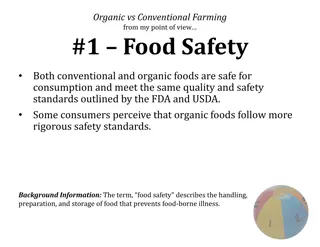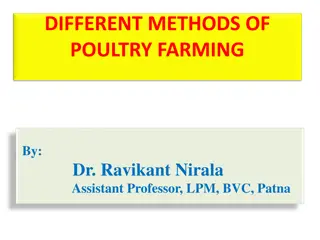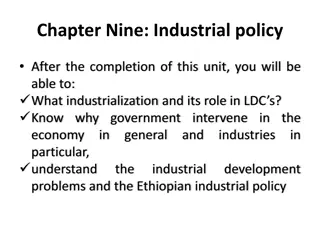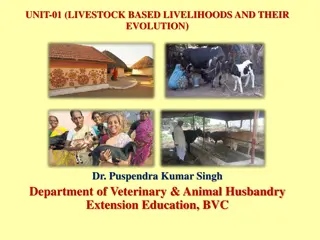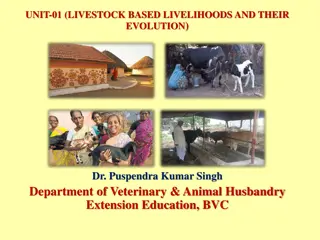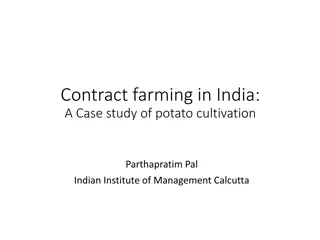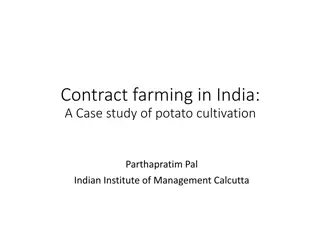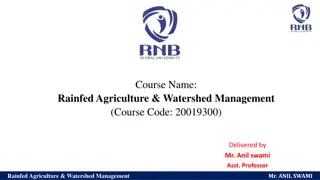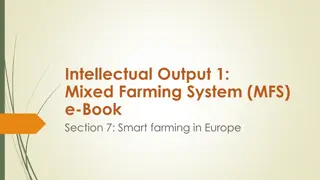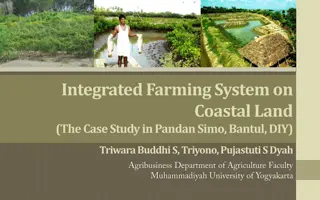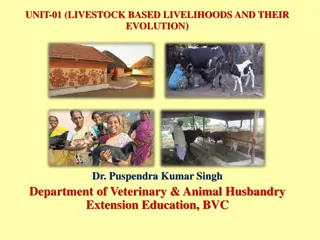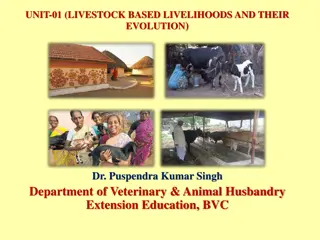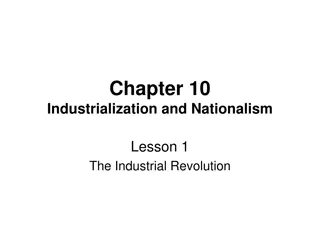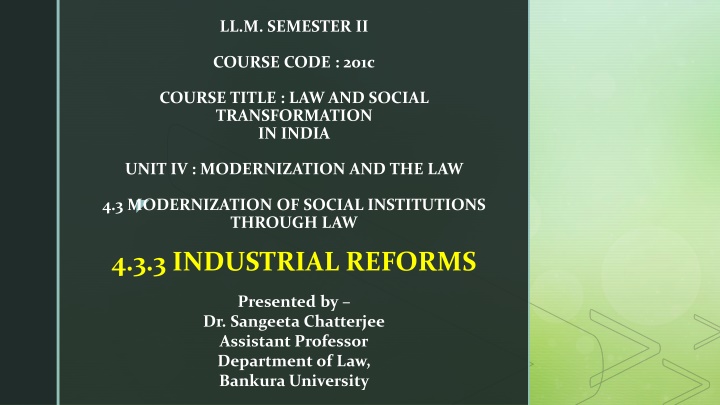
Industrialization of Agriculture: Modernizing Farming Practices
Industrialization of agriculture focuses on modernizing farming practices to bridge economic gaps, enhance farmer livelihoods, and ensure sustainable agriculture. This process involves introducing innovations, new technologies, and financial support to improve productivity and efficiency. However, challenges such as rural indebtedness, legal regulations, and market dynamics pose obstacles to achieving effective industrialization in the agricultural sector.
Download Presentation

Please find below an Image/Link to download the presentation.
The content on the website is provided AS IS for your information and personal use only. It may not be sold, licensed, or shared on other websites without obtaining consent from the author. If you encounter any issues during the download, it is possible that the publisher has removed the file from their server.
You are allowed to download the files provided on this website for personal or commercial use, subject to the condition that they are used lawfully. All files are the property of their respective owners.
The content on the website is provided AS IS for your information and personal use only. It may not be sold, licensed, or shared on other websites without obtaining consent from the author.
E N D
Presentation Transcript
LL.M. SEMESTER II COURSE CODE : 201c COURSE TITLE : LAW AND SOCIAL TRANSFORMATION IN INDIA UNIT IV : MODERNIZATION AND THE LAW 4.3 MODERNIZATION OF SOCIAL INSTITUTIONS THROUGH LAW 4.3.3 INDUSTRIAL REFORMS Presented by Dr. Sangeeta Chatterjee Assistant Professor Department of Law, Bankura University
INTRODUCTION Industrialization contemplating rise in the levels of income, meeting the consumer demands, response to or stimulation for strengthening the economy through better economic position connected with the process. is a process of foreign trade and of all the parties
WHAT IS INDUSTRIALIZATION OF AGRICULTURE Making agriculturea dependableand sustainableavocation Bridging the gap between farming community and other sectionsof the society It contributes elimination of economicdiscrepancies to the economy through progressive The agro-based industry s support to agriculture goes a long way in making the economic position of farmers more comfortable Mutual assistance between agriculture and industry is essential for the successof both the sector
ESSENTIAL ELEMENTS OF INDUSTRIALIZATION OF AGRICULTURE It is not a sudden and dramatic formation It envisages continuing social and economic changes It includes innovations in production process, accumulation of capital and expansion of trade Introduction of capital investment, mechanization, scientific know-how about best seeds and plants Introduction of new farming method with new types of fertilizers and crop protection mechanism and fairdeal for the workers
AIMS OF INDUSTRIALIZATION OF AGRICULTURE Getting maximum profit market system through better Access to full employment Equitable protection of the farming community development and effective Providing reasonable finance into the production process better irrigation facility and Post-harvest processing and storing
CHALLENGES TO INDUSTRIALIZATION OF AGRICULTURE Rural indebtedness and law Seeds, plant varieties and farmer s rights Law on irrigation, fertilizers and insecticides Law on agricultural marketing WTO and Indian Agriculture : Challenges Legal Protection of agricultural labour and the National Rural Employment Guarantee Act, 2005 National Agricultural Policy, 2000
RURAL INDEBTEDNESS AND LAW Indian agriculturalist is born in debt , lives in debt and dies in debt is a sad realityeven now Initially, the intermediary and tenancy system had made indebtedness an inescapable trap Poverty, crop failure, unfavourable market, uneconomic spending, familial responsibilities and exorbitant rate of interest created vicious circle of rural indebtedness Exploitation by the moneylenders furtheradded to their misery Hence, regulating the money lending business by system of licensing, requirement of keeping accurate accounts and fixation of maximum rate of interest have been the need of the hour Few legislations enacted in this respect are the BOMBAY AGRICULTURAL DEBTORS RELIEF ACT, 1947, KARNATAKA DEBT RELIEF ACT, 1976, KARNATAKA AGRICULTURAL MISCELLANEOUS PROVISIONS ACT, 1974 etc CREDIT OPERATION AND
SEEDS, PLANT VARIETIES AND FARMER S RIGHTS Seeds and plantvarietiesare basic inputs foragricultural activity Traditionally, farmers were theseed keepers and seed developers But loosing self-reliance or sovereignty on seeds and depending upon the government or Multinational Companies became a future of modern agriculture The green revolution of 1960s by agricultural scientists and governmental bodies is an active step in this respect Some importantadministrative measures forthis purposeare Establishing INDIAN COUNCIL OF AGRICULTURAL RESEARCH Effectuating TECHNOLOGY PROJECT NATIONAL AGRICULTURAL INNOVATION AND Constituting NATIONAL SEED CORPORATION
SEEDS, PLANT VARIETIES AND FARMER S RIGHTS NATIONAL SEED CORPORATION performs the functions of production and supply of foundation seeds, maintaining improved seed stocks, inter-state and international marketing of seeds, coordinating certified seed production by stateagencies and providing training Few legislations passed on the issue are SEEDS ACT, 1966 SEEDS CONTROL ORDER, 1983 ENACTED UNDER THE ESSENTIAL COMMODITIES ACT, 1955 NATIONAL OIL SEEDS AND VEGETABLE OILS DEVELOPMENT ACT, 1983 NATIONAL SEEDS POLICY, 2002 SEEDS BILL, 2004 PROTECTION OF PLANT VARIETIES AND FARMERS RIGHTS ACT, 2001
SEEDS, PLANT VARIETIES AND FARMER S RIGHTS PROTECTION OF PLANT VARIETIES AND FARMERS RIGHTS ACT, 2001 intends to provide for establishing an effective system for protection of plant varieties, the rights of farmers and plant breeders and to encourage developmentof new plant varieties Under the Act, breeders are entitled to register plant variety by establishing the conditions of novelty, distinctiveness, uniformity and stability, and exclusively produce, sell, market and deal with the registered variety
LAW ON IRRIGATION, FERTILIZERS AND INSECTICIDES Technological developments relating to irrigation, fertilizers and insecticides were forerunnersof green revolutionatone stage Big and small dams, bore wells and subsidized fertilizers and pesticides made huge contribution in changing the rain-dependent traditional system of agriculture Few laws enacted in this respectare INTER-STATE WATER DISPUTES ACT, 1956 RIVER BOARD ACT, 1956 GROUNDWATER (PROTECTION) ACT, 1986 RULES FRAMED UNDER THE ENVIRONMENT FERTILISER CONTROL ORDER, 1985 INSECTICIDES ACT, 1968
LAW ON AGRICULTURAL MARKETING Indian agricultural market is traditionally tilted against the farmer due to pressure arising from poverty and inadequate credit facility, malpractices by traders and middlemen, inadequacy of institutional marketing, lack of grading and processing and lack of access to market information Fair price to the commodities produced by the farmer, adequate warehousing and credit facilities, efficient transport system, market information and organized agencies for marketing establish fair market structure Exclusivestate intervention is required for the above purpose
LAW ON AGRICULTURAL MARKETING Few legislations enacted in this respectare WAREHOUSING CORPORATION ACT, 1962 STANDARD OF WEIGHTS AND MEASURES ACT, 1976 AGRCULTURAL MARKETING AMENDMENT ACT, 1986 PRODUCE GRADING AND
WTO AND INDIAN AGRICULTURE : CHALLENGES WTO Agreement on Agriculture refers to the establishment of a fair and market oriented agricultural trading progressive reductions in agricultural support and protection It insists on improved market access, limitation on domestic support and gradual reduction of export subsidies But, these conditions are unsuitable to Indian agriculture Indian exporters cannot export without domestic help and high subsidy level Taking the chance of this situation developed countries are selling their products at international marketatavery low price This has gravely affected the Indian agriculture by making it highly competitive and less profitable system and substantially
WTO AND INDIAN AGRICULTURE : CHALLENGES Moreover, removal of international trade barriers has opened up ways for large scale inflow of agricultural products of other countries which are produced at highly cheaperrate by using cheaper labour These conditions are adversely affecting markets of developing countries like India The inequity of very high rate of tariff in developed countries and low rate in developing countries is also destroying the market of developing countries India is always defensive towards the protection of its vulnerable agricultural system Unless and until some uniformity is maintained by WTO regarding the system of trade among developed and developing countries, the countries like India will continue to suffer
LEGAL PROTECTION OF AGRICULTURAL LABOUR AND THE NATIONAL RURAL EMPLOYMENT GUARANTEE ACT, 2005 Few important legislations forprotection of agricultural labourare MINIMUM WAGES ACT, 1948 BONDED LABOUR SYSTEM (ABOLITION) ACT, 1976 INTER-STATE EMPLOYMENT AND CONDITIONS OF SERVICE) ACT, 1979 MIGRANT WORKMEN (REGULATION OF MATERNITY BENEFIT ACT, 1961 DANGEROUS MACHINES (REGULATION) ACT, 1983 AGRICULTURAL WORKERS WELFARE FUND SCHEME, 1990 UNORGANISED WORKERS SOCIAL SECURITY ACT, 2008
LEGAL PROTECTION OF AGRICULTURAL LABOUR AND THE NATIONAL RURAL EMPLOYMENT GUARANTEE ACT, 2005 NATIONAL RURAL EMPLOYMENT GUARANTEE ACT (NREGA), 2005 aims at the enhancement of livelihood security of the house- holds in rural areas of the country by providing at least 100 days of guaranteed wage employment in every financial year to every household whose adult members volunteer to do unskilled manual work and for matters connected therewith or incidental thereto
NATIONAL AGRICULTURAL POLICY, 2000 This policyaims toattain: growth rate in excess of 4% perannum in theagriculture sector, growth, that is based on conservation of soil, water and biodiversity, growth with equality, growth that is demand driven and caters, the small markets and maximises benefits from exports of agricultural products in the face of the challenges arising, from economic liberalisation and globalisation, growth that is sustainable technologically, environmentally and economically.
INDUSTRIAL REFORMS Industrial INDUSTRIAL POLICY RESOLUTION, 1948 Then the INDUSTRIES (DEVELOPMENT AND REGULATION) ACT, 1951 was enacted to implement the objectives of industrial policy through the system of licensing Other industrial policies are INDUSTRIAL POLICY RESOLUTION, 1956 INDUSTRIAL POLICY STATEMENT, 1973 INDUSTRIAL POLICY STATEMENT, 1977 INDUSTRIAL POLICY STATEMENT, 1980 INDUSTRIAL POLICY, 1991 Reforms started in India with the hands of
INDUSTRIAL REFORMS Laws enacted are MRTP ACT, 1969 COMPETITION ACT, 2002 SPECIAL ECONOMIC ZONES ACT, 2005 Basically the aims of Industrial Reforms are the regulation of industries and meticulous care to avoid concentration of economic powers for providing free atmosphere for massive schemes and investments and greater facilitative role of the Government in enabling more competitiveability to face the international market
REFERENCE : 1. Dr. P. Ishwara Bhatt, Law and Social Transformation, Eastern Book Company, Lucknow, 1stEdition, 2009. 2. Highlights on National Agriculture Policy, 2000, www.economicsdiscussion.net, visited on 04.05.2020.

